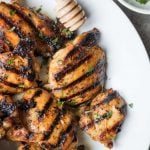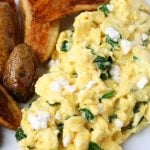Too hot to cook? Don’t feel like turning on the oven? No problem, you can enjoy these high-protein foods without cooking! These no-cook protein sources are a quick and easy way to increase your protein intake and create a well-balanced meal with minimal effort.

One of the keys to creating a balanced meal is ensuring that every meal contains a source of protein. Although, in theory, this is quite easy to do, when life gets busy or the temperature heats up, sometimes we just don’t have time or feel like roasting a whole chicken or cooking a pot beans. Fortunately, there are plenty of sources of protein that you can buy pre-cooked in the grocery store or pull out of the freezer, fridge, or pantry that require absolutely no cooking at all.
No-Cook Protein Ideas
Whether you are building a breakfast, lunch, dinner, or snack, here are 12 no-cook sources of protein that you can add to your next meal.
1. Deli Meat
Whether it’s turkey, chicken, or roast beef, deli meat and cold cuts are a great source of no-cook protein. Not only are there many different types to choose from but deli meat is an incredibly versatile source of protein that can easily be added to sandwiches, topped onto salad, or eaten on its own as a part of a simple snack-style meal. When shopping for deli meat, be sure to read the ingredients and look for less processed versions made of meat and seasonings, with a lower sodium and sugar content. A 3-ounce serving of turkey deli meat contains 19 grams of protein (1).
2. Cottage Cheese
Although all forms of cheese contain protein, cottage cheese has a particularly high protein content. Cottage cheese works well as a simple snack or side, can be topped fruit, top onto salads or toast, or mix into dips, smoothies, or baked goods such as pancakes. Not to mention, in addition to its protein content, it’s also a great source of micronutrients including calcium, phosphorus, selenium, vitamin B12, and riboflavin. A 1/2-cup serving of 2% cottage cheese contains 14 grams of protein (2).
3. Frozen Edamame
Edamame beans are the green, whole, immature soybeans, often referred to as soybeans vegetables. Much like other soy products, such as tofu and tempeh, edamame is a good source of vegetarian protein, as well as fiber. Edamame can be found in pods or shelled in the freezer section of all major grocery stores, similar to green peas. Since the edamame beans are already cooked and frozen, once thawed, they can be eaten on their own as a simple snack, added to stir-fry, or mixed into a salad for a quick and easy source of no-cook plant-based protein. A 1-cup serving of prepared edamame contains 18 grams of protein (3).
4. Canned Beans
From black to white to kidney, beans are a filling and high-fiber source of vegetarian protein and a versatile ingredient that you can eat at any meal of the day. Although beans are primarily a source of carbohydrate, with an average ratio of 3:1 carb to protein, compared to other sources of carbohydrate they have the highest concentration of protein content. Beans can easily be cooked into stews, soups, pasta, or casseroles, mixed into salads, or blended directly into sauces or dips. A 1-cup serving of cooked black beans contains 15 grams of protein (4).
5. Canned Tuna
Canned tuna is a pantry staple in many kitchens; it’s versatile, relatively inexpensive, and can last for long periods of time. In addition to being a good source of protein, tuna is an excellent source of healthy fats, most notably omega-3 fatty acids, and can be added to sandwiches, salads, pasta, or casseroles. Although tuna tends to be the most popular, all forms of canned fish and seafood, such as canned salmon, shellfish, and sardines, are incredibly nutrient-dense and convenient options. One can of water-packed tuna contains 27 grams of protein (5).
6. Hard-Boiled Eggs
If you’re making them at home, they will require a little cooking, however, you can also easily find packaged and pre-cooked boiled eggs in all major grocery stores. Whether you’re adding them to a salad, a slice of toast, or a lunch box, boiled eggs are a protein and micronutrient powerhouse complete with vitamins A, D, and E, zinc, calcium, and all of the B vitamins. A serving of 2 hard-boiled eggs contains 12 grams of protein (6).
7. Canned Chickpeas
Much like beans, chickpeas are a great source of vegetarian protein that can be used in salads, soups, stews, curries, or snacks. Also known as garbanzo beans, chickpeas are part of the legume family and, in addition to being a source of no-cook protein, are a good source of fiber and complex carbohydrates, while being moderate in calories. A 1-cup serving of cooked chickpeas contains 15 grams of protein (7).
8. Canned Lentils
Although they are quick and easy to cook, along with beans and chickpeas, lentils are a great source of no-cook protein that is easily found cooked and canned in all major grocery stores. From red to green to brown, lentils come in many different shapes, sizes, and colors and are an inexpensive and versatile ingredient in the kitchen. Lentils can be consumed hot cooked into soups, stews, chilis, and curries, eaten cold in a salad, or blended into a dip. A 1-cup serving of cooked lentils contains 18 grams of protein (8).
9. Smoked Salmon
Cured or smoked fish of any kind makes a wonderful addition to a salad, eggs, a sandwich, pasta dish, or snack-style lunch with crackers and cheese. Smoked salmon is made by salting the fish and then curing the flesh, with either hot or cold smoke, for one or several days to remove excess moisture from the fish. The process of smoking does not diminish the nutritional value of the salmon; it is simply a method of preservation. In addition to being high in protein, smoked salmon is an excellent source of omega-3 fatty acids and vitamin B12. A 3-ounce serving of smoked salmon contains 15 grams of protein (9).
10. Greek Yogurt
All yogurt, but particularly Greek yogurt, is a good source of high-quality protein. Greek yogurt is made via the same process as regular yogurt, however, once fermented the yogurt is strained to remove excess liquid whey and lactose, reducing the natural carbohydrate content and increasing the protein content, leaving behind a thicker-textured yogurt. Greek yogurt can be eaten on its own, with granola and/or fruit, mixed into muffins or baked goods, or stirred into dressing and dips. On average, a 3/4-cup serving of Greek yogurt contains 16 grams of protein (10).
11. Jerky
Be it beef, buffalo, elk, turkey, or chicken, jerky is lean-trimmed meat that has been cut into strips and dried, cured, or smoked. The word jerky is actually derived from the Quechua word ch’arki, which means “dried, salted meat”, and the process of creating jerky is a traditional method of food preparation that was used across cultures to prevent spoilage. Generally speaking, jerky is a convenient and transportable source of no-cook protein that is high in protein and low in carbohydrates, however, not all brands are created equal, so it is best to read the ingredients to ensure that you are choosing an option made of meat, salt, and spices, with limited additives. A 3-ounce serving of beef jerky contains 27 grams of protein (11).
12. Protein Powder
While getting protein from whole foods is certainly more ideal, protein powders are a great alternative when you are in a pinch. Protein powders are dietary supplements that are concentrated sources of protein made from powdered animal or plant sources of protein, such as dairy, eggs, rice, or peas. Depending on the exact formula, protein powders are often fortified with vitamins, minerals, and/or enzymes to increase their nutritional value as they are sometimes used as a meal replacement or substitute. Protein powder can be used in many ways including on its own in water or milk, and added to smoothies, yogurt, oatmeal, or baked goods for a quick and easy boost of protein. On average, a 1-scoop serving of protein powder contains 26 grams of protein (12).
The Bottom Line
Adding protein to a meal does not need to be complicated with so many no-cook protein sources to choose from. Be it tuna, Greek yogurt, or a can of beans, there are plenty of different ways to add protein to breakfast, lunch, or dinner without any cooking at all.



























